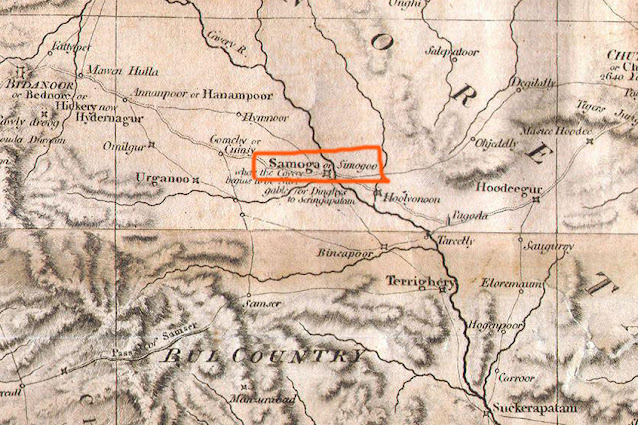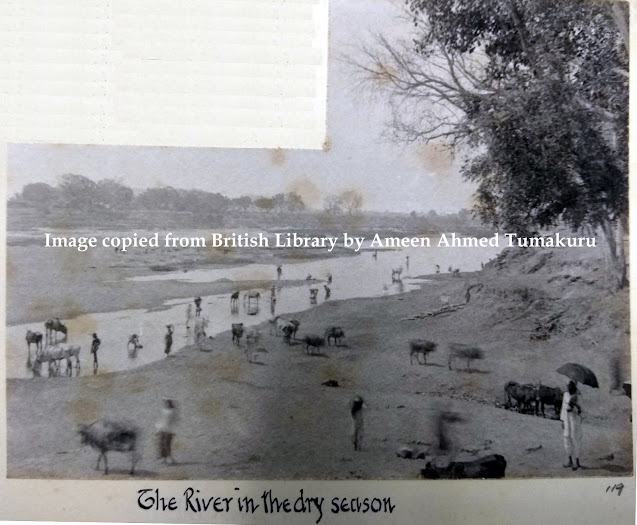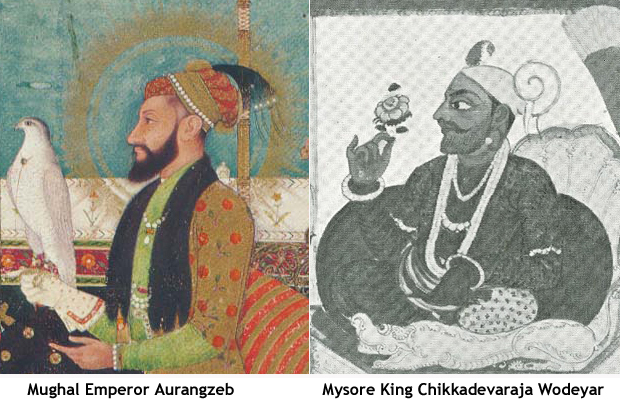Sexual violence and misdeeds of the Peshwa Maratha soldiers in Karnataka
There are many eye-witness accounts of this war, particularly the destruction wreaked by the Maratha Armies. The eyewitness accounts in English are by British soldiers who took part in the war as allies of the Marathas. Edward Moor was part of Captain Little's detachment that supported Parshuram Bhau's invasion of Mysore Kingdom in 1790-92 and published a book in 1794. (2)
The do-or-die battles
Coming back to the 3rd Anglo Mysore War, during the war the Mysoreans were clearly overwhelmed by the attack on kingdom from all sides including the sea. In early 1791, Captain Little and a Maratha Army of 12,000 horse commanded by Parshuram Bhau attacked on foot and horse from north, while another Maratha army under Hari Pant, a Brahmin, also with 12,000 horse moved in from Poona via Gooty (or Gutti, in today's Andhra Pradesh). From south-east Charles Cornwallis started off from St George, Madras (Chennai). Clearly stretched and unable to protect every inch of their territory, forces of Mysore Kingdom concentrated on protecting big towns and fortifications like Bengaluru (Anglicised - Bangalore), Dharwad (Dharwar), Chitradurga (Chittaldroog), Shivamogga (Shimoga), Mangaluru (Mangalore) among others, which saw the fiercest struggle for power.
After taking Bengaluru pete (pettah) first and then the fort adjoining it, in March 1791, Cornwallis left behind Col. Duff, commanding officer of the artillery, to command Bengaluru. He marched ahead with his army towards Srirangapatna (Anglicised- Seringapatam). On May 26, 1791, unable to find fodder and shelter, Cornwallis retreated from Kannambadi after camping for six days. After a march of only six miles towards Bengaluru, he met Parshuram Bhau’s Army together with the Bombay detachment of East India company. Bhau had marched down after capturing Dharwad in April that year, after a six-month siege that was fiercely resisted by Mysorean Commander, Badruz Zaman. Around that time the Maratha soldiers ransacked Sringeri Mutt, one of Hinduism's holiest sites, killing the priestly Brahmins and destroying the Sharada idol, the main deity there. A little later Hurry Pant’s army followed. According to Major Dirom, the Maratha soldiers marched along with the British even as the later slaughtered cattle for food. The cow being sacred to upper caste Hindus, this is another sign of how religion took a back seat in the Maratha Empire's hunger for power and wealth.
Instead of attacking Srirangapatna straight away, Cornwallis decided to focus on the forts and towns that had not fallen or were taken back by the Mysoreans. In early July 1791, Parshuram Bhau's army and Captain Little’s Bombay detachment moved north towards Sira (in present day Tumakuru District) and move into interior west, while Cornwallis proceeded back to Bangalore. Making Sira as their base the Maratha soldiers of Parshuram Bhau raided nearby villages. According to Buchanan, all the villages around the town were plundered. His soldiers also attacked Mooka Nayakanahalli Kote (MN Kote village in today's Tumakuru District). On failing to capture and loot the town they carried away many young Kannadiga girls.
Parshuram Bhau continued his campaign of terror and on Sep. 1, 1791, Kanakuppa, a hill fort north-east of Jagalur. In December he marched west and on the night of Dec. 20, 1791 Holehonnur fell. On Dec. 24, Bankapoor surrendered at first summons thanks to the effect of the fall of Holehonnur. Captain Little and Appa Saib, Bahu's son then reconnoitered Shivamogga. A vast swathe of jungle surrounded the town in those days. On Dec. 29, after a ferocious battle near Gajanur, Tipu's forces led by General Reza Saib Khan (also known as Banke Nawab or Benki Nawab) were defeated.
A married Karnataka Dalit woman's honour defiled by Maratha Army's Brahmin advisor
After capturing Gajanur, Bhau and Captain Little began their siege of Shimoga fort on Jan. 2, 1792 according to Dirom. The next day at noon the fort was breached. Bhau destroyed all 6,000 houses inside the town, most of which were burnt. Women were raped and many were carried off. While what happened after the fall of the fort was a regular affair seen else where across Karnataka, one incident that occurred around that time shows the continued casteism of Maratha Empire towards Kannadiga Dalit women.
Here is Moor's account of the event.
---Quote---
'Simoga pettah is very large, the most so of any in this part of the country; it was of course plundered, and partly burnt by the Mahrattas; but when we were last here, a number of inhabitants had again settled in it, and had established a tolerable bazaar. Some of the streets are almost a mile long, and regularly built, but there are no handsome houses or buildings of any kind. The pettah to the eastward is covered by the river, to the northward by the fort, and from the southwest to the northwest by the line of entrenchment thrown up by Reza Sahib's army.
The army continued encamped between the fort and field of battle, in the jungle, until the 5th of January, when it moved to the north-ward of Simoga. An event of a curious nature happened a little before this time- Purseram Bhow, keeps always at his board a number of Bramins, fifty perhaps of more. One of the young men fed by his bounty, looking on the charms of a chummar's1 wife, forgot he was a Bramin, and feeling himself no more than man, supplied the cobbler's place beside his handsome spouse. This step, although in itself so more than mortally imprudent, the parties had not sufficient caution to conceal, and it was first whispered about camp by the ready tongue of scandal; at length it became so notoriously known that it could not longer be passed over. What a dilemma! Happier, ten thousand times, would it have been had he put arscenic into the victuals, for then such only as had eaten of it would have felt the bad effects; whereas now, so quickly a contamination of this kind spreads, not only the whole mess, but all with whom the members had held intercourse were defiled; so that half the Braminees2 and Bramins in camp were unclean. Very fortunately the Toombudra was not far off, but it was doubted whether even that river was sufficiently sacred to cleanse them from their impurities. The Bhow, however, to be on the sure side, not only used the water but weighed himself at Koorly, a sacred village at the confluence of the Toom and Budra, against gold and and silver, which amounting to eight or ten thousand rupees, he distributed among the Bramins. By these prudent measures the Bhow, it was thought, was not much the worse (in pocket excepted) from this untoward accident.
We were once informed (but do not, although we have no reason to doubt it, give the information as authentic) that the Bhow, but for this unpleasant accident, would not have moved his army farther westward than the confines of the Chittledroog province, or to Changerry; but being himself, and so many of his sanctified brethren, in a state of abomination, he knew that neither Hurry Punt, nor any of the Bramins with the grand army, would hold conference with him or them, until made clean; and was necessitated therefore to proceed to the Toombudra, as the nearest river capable of affording them the necessary purification. Being arrived at the river, and so near Hooly Honore, a fort in the enemy's hands, he found no time would be lost, if our detachment were employed in reducing it, while he made preparations for the important ceremonies of washing and weighing. Encouraged by the fall of this fort, he was induced, there being still a short time before the plan of co-operation with General Abercomby's army could commence, to attempt the reduction of Simoga, and its preparatory steps as already detailed.
'Now if it really was the case, that the Bhow's movement to the westward, toward the Bednore country, was caused by his uncleanliness, we shall have seen a fine country over run and ruined, forts stormed, armies defeated, an enterprize undertaken, in which were involved the eventual successes of the war, consequently the British interests in the East and all ("what great eddects arise from little things!")- because- a Bramin kissed a cobler's wife!
Around the time when battles were fought around Shivamogga, the Maratha Armies also captured the nearby Kudli village which was plundered and burnt. Parshuram Bhau's men did not even spare the Kudali Swamy Mutt which was burnt. The Maratha soldiers are said to have murdered all Shudras of the town in cold-blood despite them being unarmed and not taking part in the war. A months ago, in mid-1791, the cavalry of Marathas attacked Sringeri Mutt, one of Hinduism's sites and went to the extent of destroying the centuries' old idol of Sharada, the chief deity there.
Conclusion
The Maratha invasion of Karnataka (erstwhile Mysore Kingdom) during the 3rd Anglo Mysore War (1790-92) saw them repeat on a mass scale what they had been doing to Kannadigas since Shivaji's burning and plundering of Karnataka's towns and markets in 1670s (7). His son Sambha (alias Sambhaji) continued where Shivaji left. The surrender of Margaon (in present day Goa state) to his army in Dec. 1683 is summarised in the following manner by a contemporary writer:
"There were about 200 women in the church,...and the enemy were so barbarous that they ravished those whom they liked. Many of the women of Margaon...threw themselves into the wells and were drowned. Others, who valiantly resisted the evil designs of some of the enemy's soldiers were killed by the sword or by having their breasts cut off. The same thing occurred throughout the lands of Salsette traversed by the enemy."
Their massacres as well as rapes of women, including fellow Hindus, and acts to reinforce Brahminical hierarchy and supremacy shows their true colours.
Foot notes by Moor:
---Quote---
1 A chummar is a very low cast of Hindoos; the case of coblers and leather manufacturers.
2 The female part of Brahmin's families.
---Unquote---
Original and Anglicised names:
Simoga - Shivamogga or Shimoga
Pettah - Pete (town)
Purseram Bhow - Parshuram Bhau/ Parsuram Bahu
Bramin - Brahmin or Brahman, the group of men and women occupying the highest position in the Hindu social system due to their birth
Chummar - Chamar, a caste of Hindu backward caste, that has been forced to work as cobblers by Brahminical hierarchy for centuries. This word is not used in contemporary language today. Some consider it derogatory
Arscenic into the victuals - Poison in food
Toombudra - Tungabhadra river
Koorly - Kudli or Koodli, a village near Shivamogga at the confluence of the rivers Tunga and Bhadra
Toom - Tunga
Budra - Bhadra
Musselmans - Muslims
Hindoos - Hindus
Chittledroog - Chitradurga
Changerry - Chennagiri
Hurry Punt - Hari Pant
Hooly Honore - Hole Honnur
Bednore - Bidanoor/ Bidanur
References:
1) James Rennell, 1792, Downloaded from the website of Royal Collection Trust on Aug. 25, 2020.
2) Moor, Edward., 'A narrative of the operations of Captain Little's detachment, and of the Mahratta army, commanded by Purseram Bhow; during the late confederacy in India, against the Nawab Tippoo Sultan Bahadur', J.Johnson, London, 1794.
3) Dirom, Alexander., 'A narrative of the campaign in India, which terminated the war with Tippoo Sultan in 1792', 1793.
4) 'A journey from Madras through the countries of Mysore, Canara, and Malabar', in three volumes, 1807.
5) William Faden, 'A Map of the Peninsula of India'. Provided to Wikimedia Commons by Geographicus Rare Antique Maps.
6) 'Ellis Collection: Album depicting missionary life in South India', India Office Select Materials, British Library, London, UK.
7) Gazetteer of the Bombay Presidency, vol. XV, Part 2 - Kanara, 1883.







Comments
Post a Comment
Thank you for visiting this blog and sharing your thoughts.